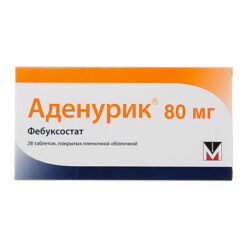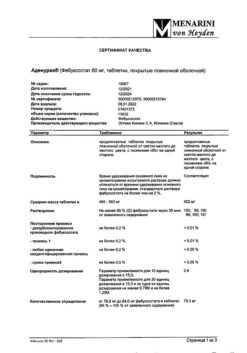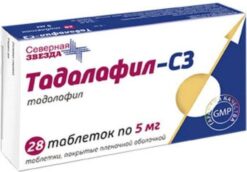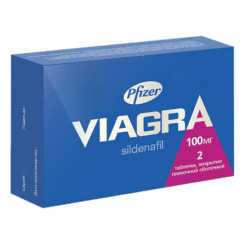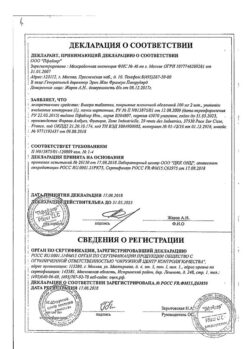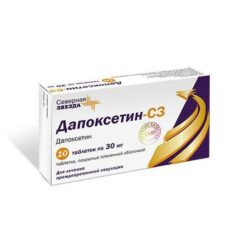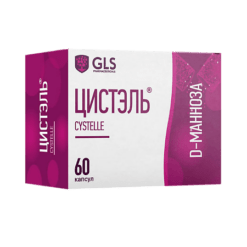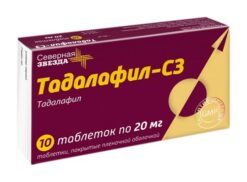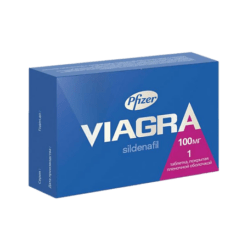No products in the cart.
Adenuric, 120 mg 28 pcs
€120.46 €100.38
Description
Chronic hyperuricaemia in conditions accompanied by deposition of urate crystals (in the presence of tophi and/or gouty arthritis, including a history).
The treatment and prevention of hyperuricaemia in adult patients undergoing cytostatic therapy for hemoblastosis with a moderate to high risk of tumor decay syndrome (120 mg dosage only).
The drug Adenuric® is intended for use in adults.
Indications
Indications
Chronic hyperuricemia in conditions accompanied by deposition of urate crystals (in the presence of tophi and/or gouty arthritis, including a history).
Treatment and prevention of hyperuricemia in adult patients during cytostatic therapy of hemoblastoses with a moderate to high risk of developing tumor collapse syndrome (only for a dosage of 120 mg).
Adenuric® is intended for use in adults.
Pharmacological effect
Pharmacological effect
Antigout drug – xanthine oxidase inhibitor.
Special instructions
Special instructions
Acute attack of gout
The use of Adenuric® should be started only after an acute attack of gout has subsided. Starting to use the drug Adenuric® can provoke the development of an acute attack of gout due to the release of urates from tissue depots and a subsequent increase in the concentration of uric acid in the blood serum.
To prevent gout attacks, in the absence of contraindications, simultaneous use of NSAIDs or colchicine for at least 6 months is recommended.
If an attack develops while using the drug Adenuric®, the use of the drug should be continued and, at the same time, appropriate treatment of an acute attack of gout should be carried out. With long-term use of the drug Adenuric®, the frequency and severity of gout attacks decrease.
Xanthine deposition
In rare cases, in patients with accelerated urate formation (for example, against the background of malignant neoplasms or Lesch-Nyhan syndrome), a significant increase in the absolute concentration of xanthines in the urine may occur, which may be accompanied by their deposition in the urinary tract. This phenomenon was not observed when febuxostat was used in the FLORENCE study in patients with tumor collapse syndrome. Due to limited data, the use of Adenuric® in patients with Lesch-Nyhan syndrome is not recommended.
Mercaptopurine/azathioprine
Concomitant use with mercaptopurine and azathioprine is not recommended. If simultaneous use is necessary, to reduce the toxic effect on the hematopoietic system, it is recommended to reduce the dose of mercaptopurine/azathioprine and careful medical monitoring.
Theophylline
With simultaneous use of febuxostat in healthy volunteers at a dose of 80 mg 1 time per day and a single dose of theophylline 400 mg, no changes in pharmacokinetic parameters were observed. Thus, the simultaneous use of febuxostat at a dose of 80 mg and theophylline does not carry the risk of increasing the concentration of theophylline in the blood plasma. Concomitant use of febuxostat 120 mg and theophylline has not been studied.
Patients who have undergone organ transplantation
The use of Adenuric® in patients who have undergone organ transplantation is not recommended due to the lack of experience with its use.
Allergic and hypersensitivity reactions
During post-marketing use, there have been rare reports of severe allergic reactions (hypersensitivity reactions), including Stevens-Johnson syndrome, toxicodermal necrolysis, anaphylactic reactions and shock.
In most cases, these reactions developed during the first month of using Adenuric®. Some patients had a history of renal failure and/or hypersensitivity reactions during the use of allopurinol.
In isolated cases, severe hypersensitivity reactions, including drug reaction syndrome with eosinophilia and systemic symptoms (DRESS), were accompanied by fever, changes in blood counts, and impaired liver or kidney function.
Patients should be informed of the possible signs and symptoms of allergic reactions (hypersensitivity reactions), and should be closely monitored for the development of symptoms of allergic reactions/hypersensitivity reactions.
In the event of severe allergic/hypersensitivity reactions, including Stevens-Johnson syndrome, it is necessary to immediately stop using Adenuric® (earlier discontinuation is associated with a better prognosis). Repeated use of the drug is not recommended.
Cardiovascular diseases
The use of Adenuric® is not recommended in patients with coronary heart disease or congestive heart failure.
In the APEX and FACT trials (as opposed to the CONFIRMS trial), the total febuxostat group compared with the allopurinol group had an increase in the number of cardiovascular events defined in accordance with the Antiplatelet Therapy Cooperative Analysis Group (CAAT) system and including death from cardiovascular causes, non-fatal myocardial infarction, non-fatal stroke) – 1.3 compared with 0.3 cases per 100 patient-years. Pooled data from phase III clinical trials (APEX, FACT and CONFIRMS studies) showed an incidence of 0.7 cardiovascular events compared with 0.6 per 100 patient-years.
In long-term large-scale studies, the incidence of cardiovascular events in HSAAT was 1.2 and 0.6 cases per 100 patient-years for febuxostat and allopurinol, respectively. The differences were not statistically significant, and a cause-and-effect relationship between these disorders and the use of febuxostat was not established. A history of the following conditions was identified as risk factors for the development of these events in patients: atherosclerosis and/or myocardial infarction, or congestive heart failure.
Prevention and treatment of hyperuricemia in patients at risk of developing tumor collapse syndrome
In patients receiving cytostatic therapy for hemoblastoses with a risk of developing moderate to severe tumor decay syndrome, the use of Adenuric®, if indicated, should be carried out under the supervision of a cardiologist.
Liver diseases
According to pooled data from phase III clinical trials, mild liver dysfunction was observed in 5% of patients using febuxostat. Before prescribing Adenuric®, it is recommended to assess liver function, and, if indicated, also during use.
Thyroid diseases
In extended long-term open studies with long-term use of febuxostat, 5.5% of patients experienced an increase in the concentration of thyroid-stimulating hormone (>5.5 μIU/ml), and therefore Adenuric® should be prescribed with caution to patients with impaired thyroid function.
The drug Adenurik® contains lactose, therefore its use in patients with lactase deficiency, hereditary lactose intolerance, and glucose-galactose malabsorption syndrome is contraindicated.
Impact on the ability to drive vehicles. Wed and fur.:
When taking the drug Adenurik®, drowsiness, dizziness, paresthesia and blurred vision may occur and, as a result, a decrease in reaction and ability to concentrate, therefore, while using the drug Adenurik®, care must be taken when driving vehicles and engaging in other potentially hazardous activities that require concentration and speed of psychomotor reactions.
Active ingredient
Active ingredient
Febuxostat
Composition
Composition
Core:
Active ingredient:
febuxostat – 120.0 mg.
Excipients:
lactose monohydrate – 114.75 mg,
hyprolose – 18.00 mg,
microcrystalline cellulose (Avicel PH 101) – 193.50 mg,
microcrystalline cellulose (Avicel PH 102) – 258.75 mg,
croscarmellose sodium – 37.50 mg,
magnesium stearate – 3.75 mg,
colloidal silicon dioxide aqueous – 3.75 mg.
Film coating: opadry® II yellow 85F42129, consisting of: polyvinyl alcohol, titanium dioxide (E 171), macrogol 3350, talc, yellow iron oxide dye (E 172) – 19.23 mg.
Contraindications
Contraindications
– Hypersensitivity to febuxostat and/or any of the excipients;
– children under 18 years of age;
– pregnancy and breastfeeding;
– hereditary galactose intolerance, lactase deficiency and glucose and galactose malabsorption syndrome.
With caution:
– Severe renal failure (creatinine clearance <30 ml/min) (efficacy and safety have not been sufficiently studied);
– liver failure;
– history of allergic reactions;
– coronary heart disease;
– congestive heart failure;
– diseases of the thyroid gland;
– simultaneous use with mercaptopurine/azathioprine (it is possible to increase the concentration of these substances in the blood plasma and increase their toxicity);
– conditions after organ transplantation (experience with febuxostat is limited);
– Lesch-Nyhan syndrome (experience with febuxostat is limited).
Side Effects
Side Effects
Taking into account the different nature of the course of gout and tumor decay syndrome, side effects when using febuxostat for these nosologies of action are presented separately.
Gout
The most common side effects in patients with gout when using febuxostat based on the results of clinical studies (4072 patients taking febuxostat at a dose of 10 mg to 300 mg) and according to post-marketing surveillance data were: gout attack, liver dysfunction, diarrhea, headache, nausea, skin rash and swelling.
In most cases, these phenomena were characterized by mild or moderate severity. During post-marketing surveillance, rare cases of hypersensitivity reactions to febuxostat, accompanied in some cases by systemic symptoms, have been reported.
Possible side effects are listed below according to the World Health Organization classification in descending frequency of occurrence: very common (≥1/10); often (≥1/100, < 1/10), uncommon (≥1/1000, < 1/100), rare (≥1/10000, < 1/1000), very rare (< 1/10000), including isolated reports.
The incidence of side effects is based on data from clinical studies and post-marketing experience with febuxostat.
From the blood and lymphatic system
Rarely: pancytopenia, thrombocytopenia.
From the immune system
Rarely: anaphylactic reactions*, hypersensitivity reactions*.
From the nervous system
Often: headache;
Uncommon: dizziness, paresthesia, hemiparesis, drowsiness, changes in taste perception, hyposthesia, hyposmia (decreased sense of smell).
From the endocrine system
Uncommon: increased concentration of thyroid-stimulating hormone (TSH) in blood plasma.
Metabolism and nutrition
Common: attacks of gout***;
Uncommon: diabetes mellitus, hyperlipidemia, loss of appetite, weight gain;
Rarely: weight loss, increased appetite, anorexia.
From the mental side
Uncommon: decreased libido, insomnia;
Rarely: nervousness.
From the side of the organ of vision
Rare: blurred vision.
Hearing and labyrinth disorders
Rarely: tinnitus.
From the side of the heart
Uncommon: atrial fibrillation, palpitations, ECG changes, left bundle branch block (see section “Tumor Collapse Syndrome”), sinus tachycardia (see section “Tumor Collapse Syndrome”).
From the side of blood vessels
Uncommon: increased blood pressure, flushing of the face, feeling of heat, hemorrhage (see section “Tumor Collapse Syndrome”).
From the respiratory system, chest organs and mediastinum
Uncommon: dyspnea, bronchitis, upper respiratory tract infection, cough, chest pain, chest discomfort.
From the digestive tract
Common: diarrhea**, nausea;
Uncommon: abdominal pain, bloating, gastroesophageal reflux disease, vomiting, dry oral mucosa, dyspeptic symptoms, constipation, frequent stools, flatulence, abdominal discomfort;
Rarely: pancreatitis, ulcerative stomatitis.
From the liver and biliary tract
Common: liver dysfunction**;
Uncommon: cholelithiasis;
Rarely: hepatitis, jaundice*, liver damage*.
From the skin and subcutaneous tissues
Common: skin rash (including the various types of rash mentioned below with lower frequency);
Uncommon: dermatitis, urticaria, pruritus, skin discoloration, skin lesions, petechiae, macular rash, maculopapular rash, papular rash;
Rarely: toxicodermal necrolysis*, Stevens-Johnson syndrome*, angioedema*, drug reaction with eosinophilia and systemic symptoms* (see section “Special Instructions”), severe forms of generalized rash*, erythema, exfoliative rash, follicular rash, vesicular rash, pustular rash, pruritic rash*, erythematous rash, morbilliform rash, alopecia, hyperhidrosis.
From the musculoskeletal system
Uncommon: arthralgia, arthritis, myalgia, musculoskeletal pain, muscle weakness, muscle spasm, muscle tension, bursitis;
Rare: rhabdomyolysis*, joint stiffness, muscle stiffness.
Renal and urinary tract disorders
Uncommon: renal failure, nephrolithiasis, hematuria, pollakiuria, proteinuria;
Rarely: tubulointerstitial nephritis*, urinary urgency.
From the reproductive system
Uncommon: erectile dysfunction.
General disorders
Common: swelling;
Uncommon: increased fatigue;
Rarely: thirst.
Influence on the results of laboratory and instrumental studies
Uncommon: increased plasma amylase activity, decreased platelet count, decreased leukocyte count, decreased lymphocyte count, increased plasma creatine and creatinine levels, decreased hemoglobin, increased plasma urea concentration, increased plasma triglyceride concentration, increased plasma cholesterol concentration, decreased hematocrit, increased plasma lactate dehydrogenase activity, increased plasma potassium content.
Rarely: increased concentration of glucose in the blood plasma, prolongation of the activated partial thromboplastin time, decreased number of red blood cells, increased activity of alkaline phosphatase in the blood plasma.
* Side effects observed during post-marketing surveillance.
**Noninfectious diarrhea and liver disorders observed in phase III studies were more common during concomitant use of colchicine.
***Additional information regarding the development of acute attacks of gout in the “Special Instructions” section.
Description of individual side effects
During post-marketing use, there have been rare reports of severe allergic reactions (hypersensitivity reactions), including Stevens-Johnson syndrome, toxicodermal necrolysis, anaphylactic reactions and shock.
Stevens-Johnson syndrome and toxicodermal necrolysis are characterized by a progressive skin rash accompanied by bullous lesions of the skin or mucous membranes, as well as eye irritation.
Hypersensitivity reactions to febuxostat may also include the following symptoms: skin reactions characterized by infiltrative maculopapular rashes; generalized or exfoliative rash, as well as skin lesions, facial swelling, fever, hematopoietic disorders such as thrombocytopenia and eosinophilia, and involvement of one or more organs (liver and kidneys, including tubulointerstitial nephritis).
Attacks of gout usually occur soon after starting the use of Adenuric® and during the first months of therapy. Subsequently, the frequency of attacks decreases. It is recommended to prevent the development of acute attacks of gout.
Tumor collapse syndrome
In the FLORENCE study, side effects were reported in 22 patients (6.4%). In both groups (febuxostat group and allopurinol group), the incidence of side effects was the same (11 patients each, 6.4%). In most cases, adverse events were mild or moderate in severity. Overall, with the exception of the three adverse events listed below from the FLORENCE study, no significant safety profile was observed for febuxostat beyond that for gout.
From the side of the heart
Uncommon: left bundle branch block, sinus tachycardia.
From the side of blood vessels
Uncommon: hemorrhage
Interaction
Interaction
Mercaptopurine/azathioprine
Concomitant use with mercaptopurine and azathioprine is not recommended, because Inhibition of xanthine oxidase by febuxostat may lead to an increase in the concentration of mercaptopurine and azathioprine in the blood plasma and an increase in their toxic effect. No studies have been conducted to study the interaction of febuxostat and substances metabolized by xanthine oxidase.
Cytostatics
No studies have been conducted to study drug interactions between febuxostat and cytotoxic drugs. In the FLORENCE study, febuxostat 120 mg was used for tumor collapse syndrome in patients undergoing various types of cytotoxic therapy (including monoclonal antibody therapy). However, since no drug interaction studies have been conducted between febuxostat and cytotoxic drugs, a potential interaction between febuxostat and concomitantly administered cytotoxic chemotherapy drugs cannot be excluded.
Rosiglitazone/CYP2C8 substrates
According to in vitro data, febuxostat is a weak inhibitor of the CYP2C8 isoenzyme. In healthy volunteers, with simultaneous use of 120 mg of febuxostat once a day and a single dose of 4 mg of rosiglitazone, no changes in the pharmacokinetic parameters of rosiglitazone and its metabolite N-dismethyl rosiglitazone were noted, which indicates that febuxostat does not have the properties of an inhibitor of the CYP2C8 isoenzyme in vivo. When using febuxostat and rosiglitazone (or other substrates of the CYP2C8 isoenzyme) simultaneously, no dose adjustment is required.
Theophylline
When other xanthioxidase inhibitors were used concomitantly with theophylline, an increase in the concentration of theophylline in the blood plasma was observed. With the simultaneous use of febuxostat at a dose of 80 mg 1 time per day and a single dose of theophylline 400 mg in healthy volunteers, no changes in the pharmacokinetic parameters or tolerability of theophylline were observed, thus, no special precautions are required with the simultaneous use of febuxostat at a dose of 80 mg and theophylline. Concomitant use of febuxostat 120 mg and theophylline has not been studied.
Naproxen and other glucuronidation inhibitors
The metabolism of febuxostat depends on the activity of the enzyme uridine diphosphate glucuronyl transferase (UDPGT). Drugs that inhibit glucuronidation, such as non-steroidal anti-inflammatory drugs (NSAIDs) and probenecid, may potentially interfere with the elimination of febuxostat. In healthy volunteers, with simultaneous use of febuxostat and naproxen at a dose of 250 mg 2 times a day, an increase in febuxostat Cmax by 28%, AUC by 41% and T1/2 by 26% was observed. In clinical studies, concomitant use of febuxostat and naproxen or other NSAIDs/COX-2 inhibitors was not associated with a clinically significant increase in the incidence of adverse events. No dose adjustment is required when febuxostat and naproxen are used concomitantly.
Glucuronidation inducers
With simultaneous use of febuxostat with strong inducers of glucuronidation, its metabolism may be increased and its effectiveness may be reduced. With simultaneous use, it is necessary to monitor the concentration of uric acid in the blood serum 1-2 weeks after the start of therapy. When the glucuronidation inducer is discontinued, the Cmax of febuxostat may increase. Colchicine/indomethacin/hydrochlorothiazide/warfarin
Febuxostat can be used concomitantly with colchicine or indomethacin without dose adjustment.
Also, no dose adjustment of febuxostat is required when used concomitantly with hydrochlorothiazide.
Concomitant use of febuxostat (80 mg or 120 mg once daily) with warfarin does not affect the pharmacokinetics of warfarin, INR (international normalized ratio) and factor VII activity in healthy volunteers. When febuxostat is used concomitantly with warfarin, no warfarin dose adjustment is required.
Desipramine/CYP2D6 substrates
According to in vitro data, febuxostat is a weak inhibitor of the CYP2D6 isoenzyme. In a study in healthy volunteers, febuxostat administered at a dose of 120 mg once daily showed an increase in the AUC of desipramine (CYP2D6 substrate) by 22%, indicating a weak inhibitory effect of febuxostat on the CYP2D6 isoenzyme in vivo. Thus, with simultaneous use of febuxostat and substrates of the CYP2D6 isoenzyme, no dose adjustment is required.
Antacids
When used simultaneously with antacids containing magnesium hydroxide or aluminum hydroxide, there was a decrease in the absorption of febuxostat (by approximately 1 hour) and a decrease in Cmax by 32%, but the AUC of febuxostat did not change significantly. Thus, febuxostat can be taken simultaneously with antacids.
Overdose
Overdose
In case of drug overdose, symptomatic and supportive therapy is indicated.
Symptoms: increased side effects.
Shelf life
Shelf life
3 years.
Do not use after the expiration date stated on the package.
Manufacturer
Manufacturer
Berlin-Chemie AG/Menarini-Von Heiden GmbH, Germany
Additional information
| Shelf life | 3 years. Do not use after the expiration date printed on the package. |
|---|---|
| Manufacturer | Menarini-Von Heyden GmbH, Germany |
| Medication form | pills |
| Brand | Menarini-Von Heyden GmbH |
Other forms…
Related products
Buy Adenuric, 120 mg 28 pcs with delivery to USA, UK, Europe and over 120 other countries.


